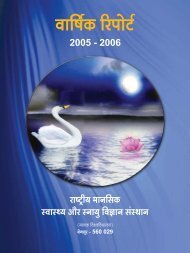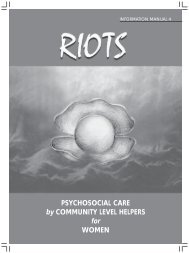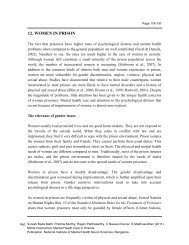An illicit alcohol production center in rural Bangalore - Nimhans
An illicit alcohol production center in rural Bangalore - Nimhans
An illicit alcohol production center in rural Bangalore - Nimhans
Create successful ePaper yourself
Turn your PDF publications into a flip-book with our unique Google optimized e-Paper software.
Users are gett<strong>in</strong>g younger<br />
That the latter cause of under-estimation may be operative, can be deduced from the fact that the<br />
mean age of the dr<strong>in</strong>k<strong>in</strong>g population is above forty years, whereas the age at which the bulk of<br />
respondents admitted to hav<strong>in</strong>g had their first dr<strong>in</strong>k and the age by which they had begun regular<br />
dr<strong>in</strong>k<strong>in</strong>g is near 20 years. This would allow us to presume that a proportion of young people at the<br />
beg<strong>in</strong>n<strong>in</strong>g of their dr<strong>in</strong>k<strong>in</strong>g careers have evaded detection.<br />
This is important as there is evidence from work conducted on heavy <strong>alcohol</strong> users from this same<br />
population, that the average age at which males start regular dr<strong>in</strong>k<strong>in</strong>g has dropped to 23 years<br />
[1998] from 25 years <strong>in</strong> 1988. The mean age by which they developed significant <strong>alcohol</strong><br />
dependence dropped to 29 years from 35 years <strong>in</strong> the same time period (Benegal, 1998).<br />
The data gathered from this study also po<strong>in</strong>ts to a significant cohort effect on age at <strong>in</strong>itiation of<br />
<strong>alcohol</strong> use. This po<strong>in</strong>ts to a progressive lower<strong>in</strong>g of the age at which consumers over time have<br />
their first dr<strong>in</strong>k of <strong>alcohol</strong>.<br />
There are strong <strong>rural</strong> - urban differences<br />
<strong>in</strong> prevalence of use<br />
Prevalence of dr<strong>in</strong>k<strong>in</strong>g appears<br />
significantly higher <strong>in</strong> <strong>rural</strong> areas<br />
compared to urban areas, with (61% vs.<br />
39%) or without (52% vs. 48%) the<br />
<strong>in</strong>clusion of the tribal sample <strong>in</strong> the <strong>rural</strong><br />
sector. Tribal areas had the highest<br />
prevalence of <strong>alcohol</strong> use <strong>in</strong> both men and<br />
women.<br />
The prevalence of <strong>alcohol</strong> consumption is<br />
related to education and <strong>in</strong>come levels<br />
Absta<strong>in</strong>ers were significantly likely to be<br />
better educated and have higher family<br />
<strong>in</strong>comes than <strong>alcohol</strong> users except <strong>in</strong> the<br />
tribal population. Previous studies have<br />
also documented similar f<strong>in</strong>d<strong>in</strong>gs that<br />
<strong>alcohol</strong> use is more common among lower<br />
socio-economic groups. The popular<br />
explanation that <strong>alcohol</strong> provides a way of<br />
cop<strong>in</strong>g with poverty and deprivation, may<br />
certa<strong>in</strong>ly expla<strong>in</strong> this phenomenon.<br />
However, one needs to consider, <strong>in</strong> the<br />
context of social trends <strong>in</strong> India, the<br />
<strong>in</strong>terest<strong>in</strong>g phenomenon of sanskritisation,<br />
<strong>in</strong> which as a result of social and<br />
economic mobility, people of lower<br />
socioeconomic class adopt the mores of<br />
the higher castes / classes. It has been<br />
speculated, that with <strong>in</strong>creas<strong>in</strong>g education<br />
and urbanization and the resultant social<br />
and economic mobility which saw the<br />
growth of the urban middle classes <strong>in</strong><br />
India, <strong>in</strong> the last 150 years or less, there<br />
have been rapid changes <strong>in</strong> diet (<strong>in</strong> favour<br />
of vegetarianism and abst<strong>in</strong>ence from<br />
28.33<br />
19<br />
11.29<br />
15<br />
2.04<br />
Sample estimates<br />
58.34<br />
Industry estimates<br />
7<br />
Whisky<br />
Brandy<br />
Rum<br />
White spirits<br />
From: Indian Spirits Market, by RaboIndia F<strong>in</strong>ance Ltd. April 2002<br />
59<br />
75





